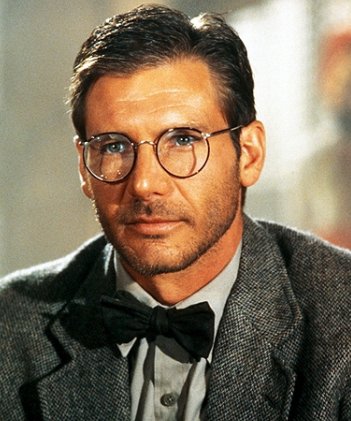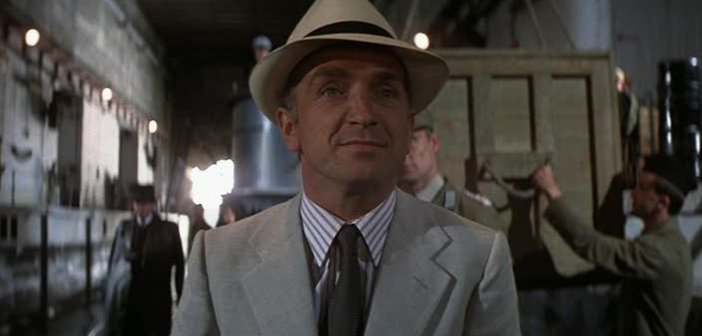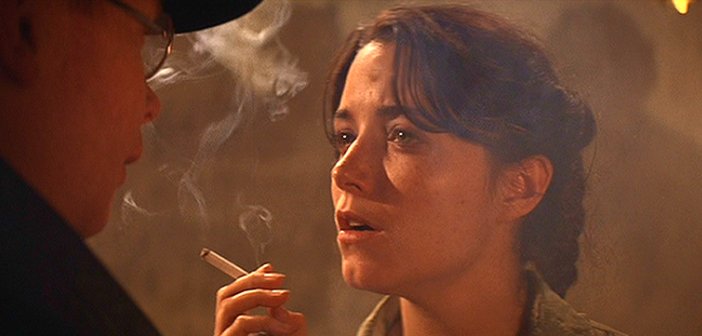Remembering Raiders of the Lost Ark – 35 Years On | Part II
Read Part One Here
Now, 35 years after it was first released, Raiders of the Lost Ark is recognised as a modern classic, and with good reason. Think of that opening sequence alone, 10 minutes of pure cinema magic – our first glimpse of Indy from the back, in silhouette, as he moves through the steamy South American jungle, the shadow and shade of the booby trapped entrance, the temple failing asunder after he substitutes the bag of sand for the idol or squeezing through the gap as the stone door descends and – probably the most iconic of them all – the boulder chase. These opening moments defined our expectations of Raiders as a film and Indy as a character, yet Indiana is only one half of his on screen persona.

Part of the magic of watching an Indiana Jones film is seeing him as Henry Jones Jr. – a mild mannered college professor, stumbling over the spelling of Neolithic or awkwardly dealing with student’s affections. While saying that Henry is Indy’s alter ego it must be stressed that the transformation between Henry and Indy is not in the same league as that of Clark Kent into Superman – there is plenty of Henry in Indy and vice versa. Across all four films, in Temple of Doom and Last Crusade especially, you can see Henry’s little awkwardness’s in Indiana, such as when he discovers the cockpit has been abandoned by the pilots in Temple of Doom and Willie asks him if can he fly a plane, or when he comes face to face with his father in the Austrian castle in Last Crusade, or realising Marion is Mutt’s mother in Crystal Skull. Those are pure Henry Jones moments yet you can see Indy in Henry too, such as his discussion with Marcus Brody about going after the Ark, punctuated by Henry tossing his pistol into his suitcase, saying with a wry smile, “you know what a cautious fellow I am.” Indy, counterbalanced by Henry, is the perfect mix of recklessness and righteousness as he does the right thing, but most often does it the hard way, just how the audience likes it.
While Indy is our hero, every hero needs a villain and in Paul Freeman’s Rene Belloq, Raiders of the Lost Ark boasts one of the best. But to call him the villain isn’t 100% correct as Belloq is not truly the bad guy – for the record, Colonel Dietrich and Toht are the bad guys. Belloq is not a maniacal, bloodthirsty character hell-bent on world destruction (yawn), Belloq is exactly what he describes himself as, “a shadowy reflection” of Indiana Jones – “you and I are very much alike. Archaeology is our religion, yet we have both fallen from the pure faith. Our methods have not differed as much as you pretend. I am but a shadowy reflection of you. It would take only a nudge to make you like me. To push you out of the light.” He is a mercenary archaeologist, he doesn’t care about preserving antiquity’s greatest treasures; he is solely in it for the glory. Comparisons between Indy and Rene find a bit of traction in the prequel as, in Temple of Doom, Indy describes going after the Shankara Stones as his shot at “fortune and glory.” Indy very much becomes a shadowy version of Belloq in Temple of Doom but unlike Belloq, he recognises it and refuses to leave Pankot Palace without the kidnapped village children.

What makes Belloq such an interesting foil for Indiana is his likeability – you want to hate him, but you can’t. You can tell from his testy interactions with Colonel Dietrich and his Nazi overlords that he has no interest in the Aryan agenda. When Marion is thrown into the snake pit you can see the shock and surprise on his face – he cared for Marion but when Dietrich casts her away he is helpless to stop it and so shows the futility of his position, he has no power outside of coordinating the dig. And he knows this. There is a palpable sense of disdain between both him and Dietrich, Belloq criticising the Nazi way of excavating “you would use a bulldozer to find a china cup,” while Dietrich is not shy in expressing his scepticism of Belloq’s intention to conduct a Hebrew ritual before the opening of the Ark. Opening the Ark is purely for his own gratification. It is a testament to Freeman’s talents as, with the sand fragments of the stone tablets streaming through his fingers, you can sense his disappointment and anguish. Yet you also know that, if the vengeance of the Lord had not started to spill from the Ark, then Dietrich would surely have spilled Belloq’s brains all over it. He neatly balanced the disappointment of the Ark opening with his fear for his own life. I have wondered for years about Belloq’s true motivations on opening the Ark. If the Ark had not unleashed the wrath of God, would it be Belloq’s army that marched on Europe and not Hitler’s? Now wouldn’t that have been interesting?
I always liked Belloq because of the mystery. We don’t know why he and Indiana don’t get along; we don’t know what he has done in his career yet Dietrich alludes to him being quite ruthless, “I am surprised to find you squeamish. That is not your reputation.” What has Belloq done in the past? Is this why Indy hates him? Were they ever friends? As a character Belloq poses more questions than he answers which ultimately keeps us interested in him, a sense of intrigue equal to that of Indiana’s. Yes, Spielberg and Lucas may have given us some of the best Indy moments in the subsequent Indiana Jones films, but they have never given us a nemesis the equal of Rene Belloq.

While speaking of both Indy and Belloq, it would be remiss not to spend a little time on Marion Ravenwood. She is unique in one particular way; Marion is Indy’s love interest, his sidekick and his damsel in distress, rarely do you find all three in the same character. Indeed, our introduction to Marion is quite the whirlwind – after winning a drinking contest with a man mountain in her crowded pub in Nepal she is reunited with her old paramour, she encounters the sadistic Toht and then helps Indy kick seven bells out of Toht’s Nazi henchmen as her pub is set ablaze and burns down around them. This all happens in about 10 minutes, an introduction equal only to that of Indy. But what do we learn of Marion in those few minutes? Quite simply that she is a perfect match for Indiana Jones. She’s feisty and full of daring-do, as able to hold herself in a drinking contest as she is in a bar fight and, maybe most importantly, we recognise the indelible mark Indy has left on her life. It should also be noted that Marion seems as much an influence on Indy as he is on her as he displays a passion for the Ark that could only have been passed to him from the Ravenwoods. Though something monumental and unspoken happened between them, knowing that an old friend and mentor needed help was enough to make Indy revisit that past. Maybe she loves him for that, for fighting for the Ark and not trying to make amends or attempts at winning her back proving, maybe, that he was worth loving in the first place.
There is one last piece to examine – the theme tune. John Williams was tasked with creating a musical signature for Indiana Jones and initially composed two separate pieces of music intending to use only one but Spielberg, besotted by both, asked Williams to combine them into what we now call The Raiders March. Based on a series of buoyant trumpet blasts, representing the hero or the heroic, and a single violin, representing virtue and love, the carefully constructed arrangement drives the theme along at near breakneck pace. It succeeds in mixing the light and the dark but at the same time never forgetting the romance in Raiders. Explaining the now famous Raiders March, Williams said he took inspiration from watching the relationship unfold between Marion and Indy, “ In Raiders of the Lost Ark, for the love story between Indiana Jones and Marion Ravenwood, I thought an emotionally larger-than-life theme would contrast well with the humour and lightness in the way Harrison Ford and Karen Allen played their scenes together.” While saying that humour and lightness sum up the Raiders March, Williams didn’t want light-heartedness, “…the music has to lure us in so it seems like it is going to be a beautiful experience and in turn itself around into something much more terrifying.”
[youtube id=”IgncJgSbbck” align=”center” autoplay=”no” maxwidth=”750"]
This conscious step in musical styling shows the careful balance that Williams maintained throughout Raiders, the constant repeating and building of the various sections into a stunning end volley that whisks the listener away on a powerful and triumphant wave. Not being a music scholar I’m afraid I can add no more to this other than saying I love the theme tune and when I see small dogs running all I can hear in my head is the Raiders March (sometimes I get the feeling that the dog can too – you see, everyone wants to be Indiana Jones!)
Raiders of the Lost Ark, a film that has defined a generation’s expectations of the action/adventure genre, is without doubt a piece of cinema magic. It is a timeless example of pure entertainment and with news of a fifth Indiana Jones adventure breaking just a few weeks ago I couldn’t help but raise a smile. Few things can elicit an emotional response as strong as something that was important to you as a child. Though Harrison Ford will be 77 years old when Indiana Jones 5 is released I know that I (and possibly others, many, many others) will, when the lights go down and the Paramount logo rises, be transported back to their six year old selves. Some could quite possibly have a little six year old of their own to introduce Indy to as well. Such is the magic; Indiana Jones is not something to covet, but to share. And even if Indiana Jones 5 does not happen, for whatever reason, we will always have Raiders of the Lost Ark, the greatest action/adventure film ever made.
Featured Image Credit

